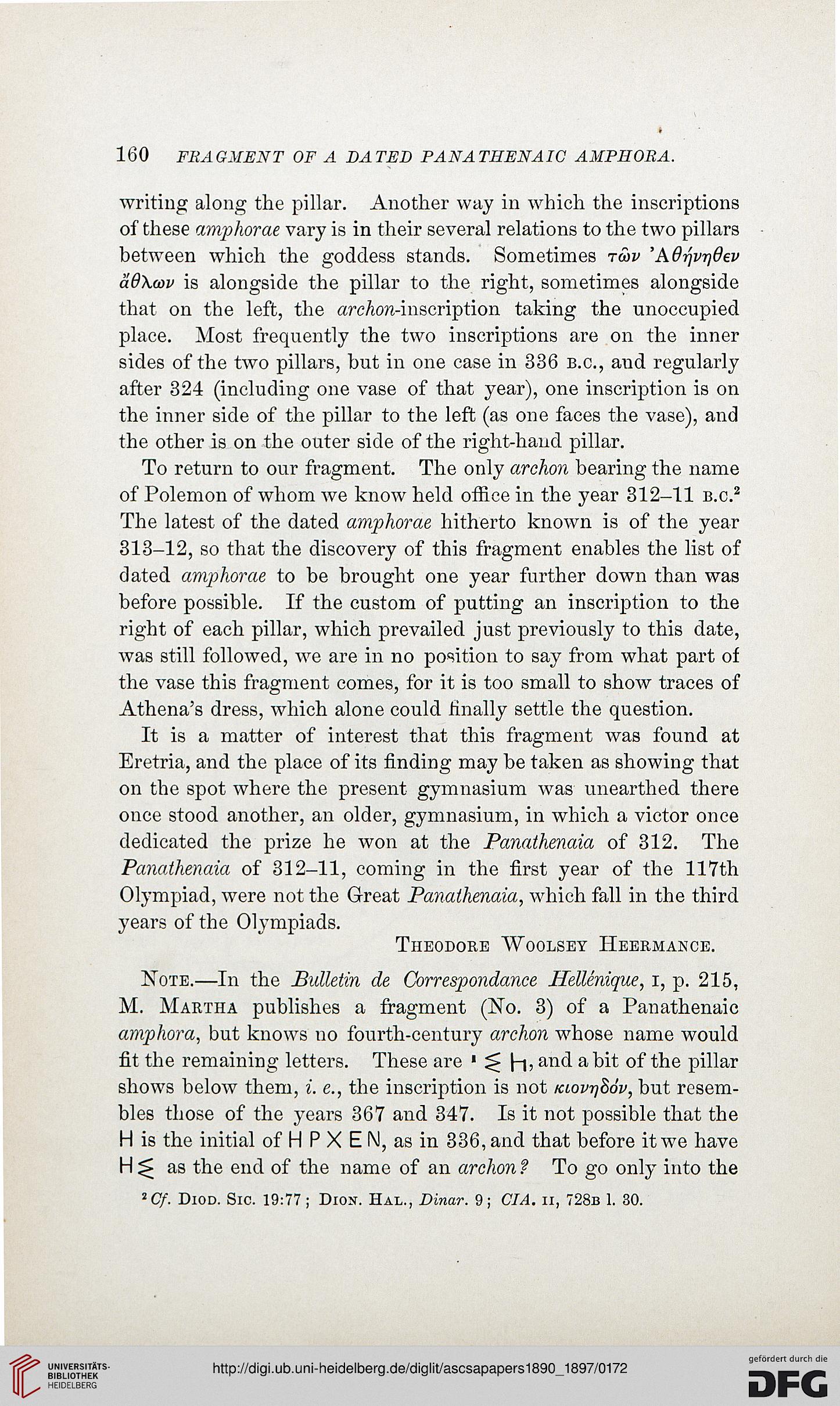160 FRAGMENT OF A DATED PAN A THEN AIC AMPHORA.
writing along the pillar. Another way in which the inscriptions
of these amphorae vary is in their several relations to the two pillars
between which the goddess stands. Sometimes toiv 'Adqvrjdev
a0Xcov is alongside the pillar to the right, sometimes alongside
that on the left, the arc/iow-inscription taking the unoccupied
place. Most frequently the two inscriptions are on the inner
sides of the two pillars, but in one case in 336 b.c., and regularly
after 324 (including one vase of that year), one inscription is on
the inner side of the pillar to the left (as one faces the vase), and
the other is on the outer side of the right-hand pillar.
To return to our fragment. The only archon bearing the name
of Polemon of whom we know held office in the year 312-11 b.c.2
The latest of the dated amphorae hitherto known is of the year
313-12, so that the discovery of this fragment enables the list of
dated amphorae to be brought one year further down than was
before possible. If the custom of putting an inscription to the
right of each pillar, which prevailed just previously to this date,
was still followed, we are in no position to say from what part of
the vase this fragment comes, for it is too small to shoAV traces of
Athena's dress, which alone could finally settle the question.
It is a matter of interest that this fragment was found at
Eretria, and the place of its finding may be taken as showing that
on the spot where the present gymnasium was unearthed there
once stood another, an older, gymnasium, in which a victor once
dedicated the prize he won at the Panathenaia of 312. The
Panathenaia of 312-11, coming in the first year of the 117th
Olympiad, were not the Great Panathenaia, which fall in the third
years of the Olympiads.
Theodore Woolsey Heermance.
Note.—In the Bulletin de Correspondance Hellenique, i, p. 215,
M. Martha publishes a fragment (No. 3) of a Panathenaic
amphora, but knows no fourth-century archon whose name would
fit the remaining letters. These are • :> (-j, and a bit of the pillar
shows below them, i. e., the inscription is not klopi]86v, but resem-
bles those of the years 367 and 347. Is it not possible that the
H is the initial of H P X E N, as in 336, and that before it we have
H :> as the end of the name of an archon ? To go only into the
2C/. Diod. Sic. 19:77 ; Dion. Hal., Dinar. 9; CIA. ii, 728b 1. 30.
writing along the pillar. Another way in which the inscriptions
of these amphorae vary is in their several relations to the two pillars
between which the goddess stands. Sometimes toiv 'Adqvrjdev
a0Xcov is alongside the pillar to the right, sometimes alongside
that on the left, the arc/iow-inscription taking the unoccupied
place. Most frequently the two inscriptions are on the inner
sides of the two pillars, but in one case in 336 b.c., and regularly
after 324 (including one vase of that year), one inscription is on
the inner side of the pillar to the left (as one faces the vase), and
the other is on the outer side of the right-hand pillar.
To return to our fragment. The only archon bearing the name
of Polemon of whom we know held office in the year 312-11 b.c.2
The latest of the dated amphorae hitherto known is of the year
313-12, so that the discovery of this fragment enables the list of
dated amphorae to be brought one year further down than was
before possible. If the custom of putting an inscription to the
right of each pillar, which prevailed just previously to this date,
was still followed, we are in no position to say from what part of
the vase this fragment comes, for it is too small to shoAV traces of
Athena's dress, which alone could finally settle the question.
It is a matter of interest that this fragment was found at
Eretria, and the place of its finding may be taken as showing that
on the spot where the present gymnasium was unearthed there
once stood another, an older, gymnasium, in which a victor once
dedicated the prize he won at the Panathenaia of 312. The
Panathenaia of 312-11, coming in the first year of the 117th
Olympiad, were not the Great Panathenaia, which fall in the third
years of the Olympiads.
Theodore Woolsey Heermance.
Note.—In the Bulletin de Correspondance Hellenique, i, p. 215,
M. Martha publishes a fragment (No. 3) of a Panathenaic
amphora, but knows no fourth-century archon whose name would
fit the remaining letters. These are • :> (-j, and a bit of the pillar
shows below them, i. e., the inscription is not klopi]86v, but resem-
bles those of the years 367 and 347. Is it not possible that the
H is the initial of H P X E N, as in 336, and that before it we have
H :> as the end of the name of an archon ? To go only into the
2C/. Diod. Sic. 19:77 ; Dion. Hal., Dinar. 9; CIA. ii, 728b 1. 30.




